#hippodrome theatre
Text
Lydia Gerrard’s ‘Glinda’ debut in this amazing production of Wicked at the Birmingham Hippodrome Theatre on 7th March 2024….we couldn’t be happier!
0 notes
Text
Musicals I've seen (Not in order):
Mean Girls
Ride the Cyclone (Community College Production)
Le Mis
Moulin Rouge
Aladdin (Somehow saw this twice)
Lion King
Wicked
Jersey Boys (Dinner theater production)
Rocky Horror Picture Show
Tina - The Tina Turner Musical
#i have a horrible memory#but if there is any mkre i forgot I'll add just for fun#i love seeing shows im so glad i hav ea big theatre nearby#im also not including high school shows#musicals#playbill#hippodrome#theatre my beloved#theater nerd
4 notes
·
View notes
Photo



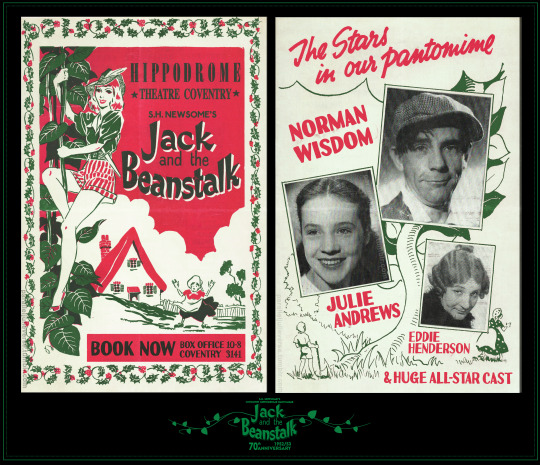
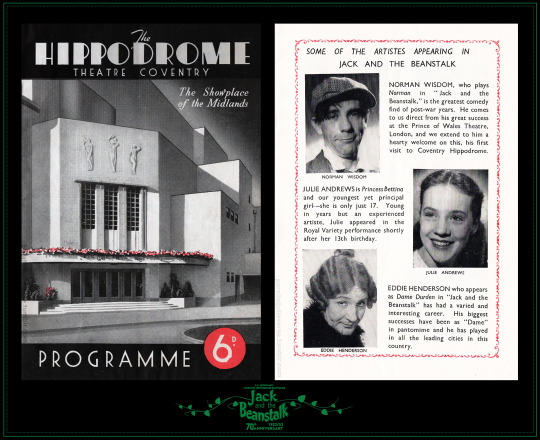



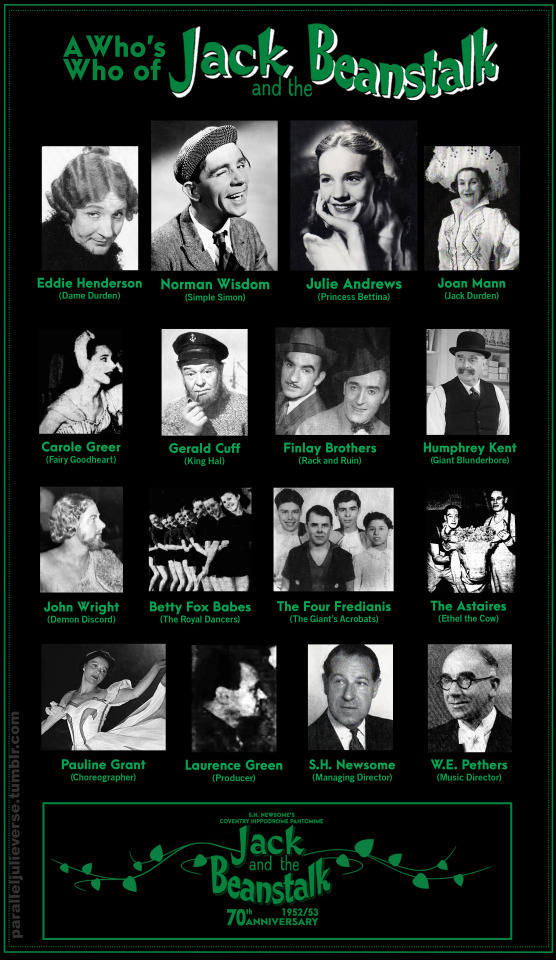
70th anniversary of Jack and the Beanstalk
Coventry Hippodrome, 164 performances
(23 December 1952 - 28 March 1953)
This week marks the 70th anniversary of a milestone event in the juvenile career of Julie Andrews: the opening of Jack and the Beanstalk at the Coventry Hippodrome on 23 December 1952. It would be Julie’s fourth annual pantomime, following Humpty Dumpty (1948), Red Riding Hood (1950) and Aladdin (1951).
That Jack and the Beanstalk was a provincial production -- rather than a West End show -- could be misconstrued as a career comedown for the young star. After all, twelve months earlier she was principal girl in Aladdin at the London Casino and the following year she would headline the 1953 production of Cinderella at the London Palladium. But an appearance at the Coventry Hippodrome was no small affair.
The Showplace of the Midlands
Dubbed “The Showplace of the Midlands”, the Hippodrome was an ultra-modern Art Deco entertainment palace lovingly built and managed by automobile industry baron cum entertainment impresario, Sam Newsome. With a massive 2000-seat auditorium, multi-levelled foyers and bars, twelve dressing rooms and its own broadcasting studio, the Hippodrome occupied over one and a quarter acres in the heart of Coventry. It was the biggest and most up-to-date theatre in the country -- and it quickly established itself as the foremost Midlands venue for touring dates, attracting a stream of headline acts and hosting regular seasons from major companies including The D'Oyly Carte Opera and Sadler’s Wells Opera (Newman 1995).
The Coventry Hippodrome was especially celebrated for its spectacular Christmas pantomimes. Newsome took “personal pride and delight in his pantomimes” and ensured they “possessed a thoroughly exclusive quality” that distinguished them from run-of-the-mill seasonal fare (Stephens 1965, 6). Planning for each year’s panto would start months in advance with generous budgets, top-notch creative talent, high production values, and big star names.
It was a calculated business strategy on Newsome’s part. Not only would each Christmas panto be an assured money-earner for his theatre, but, once it had debuted in Coventry, it would subsequently be re-mounted -- using the same scripts, sets, costumes and, sometimes, cast members -- in other theatres. It was not uncommon for a different Newsome pantomime to be playing simultaneously in five or six theatres around the country (Auty, 20; Newman, 77). In the case of Jack and the Beanstalk, for example, Newsome would re-stage the show repeatedly over ensuing years including runs at the Dudley Hippodrome in 1953/54; the Derby Hippodrome in 55/56; the Swansea Empire in 56/57; the Brighton Hippodrome in 57/58 and the Bradford Alhambra in 59/60 (The Stage).
Launching Jack and the Beanstalk
In early 1952, Newsome announced that his next Christmas pantomime at the Coventry Hippodrome would be an “entirely new and magnificent production” of Jack and the Beanstalk, a popular source for pantos since the early-19th century and a sure-fire crowd pleaser. A “firm believer in maintaining the well-loved traditional features of Pantomime”, Newsome’s production of Jack adhered faithfully to the plot of the well-known fairy tale about the adventurous village lad turned Giantslayer, but with lashings of pantomime essentials of music, spectacle, comedy and dance. (Newsome: 1).
Overseeing the production and taking on directorial duties was Laurence Green, something of a right-hand man for Newsome throughout this era. The book was developed by the celebrated lyricist team, Barbara Gordon and Basil Thomas, who were also Newsome panto regulars. Other key members of the production team included costume designer, Michael Bronze, and set designers, Josef Carl and Tod Kingman, who created a series of impressive backdrops and props including a giant hand that in one scene whisked Julie aloft into the theatre fly tower (Foxon: 6; Whetsone: 3).
In terms of music and dance, there were seventeen full musical numbers with a mix of classics, pop standards, and bespoke compositions, all arranged and orchestrated by the Hippodrome’s longtime music director, W.E. Pethers. Celebrated choreographer, Pauline Grant was commissioned to develop several dance routines including an Act 1 closing ballet sequence and a grand finale parade.*
As always, one of the most important elements in the show was its roster of on-stage talent. And for Jack and the Beanstalk, Newsome assembled a star-studded line-up from the fields of theatre, variety, film, and dance. To optimise marketing potential, the principal cast was announced in June, a full six months before the show was set to open. Julie was cast in the principal girl role of Princess Bettina, alongside Joan Mann as Jack; Eddie Henderson as Dame Durden; and, the undoubted comic star of the show, Norman Wisdom as Simple Simon (‘Norman Wisdom to star’: 6).
Stories and profiles about the stars were fed in regular instalments to the local and regional press, ensuring continued exposure and boosting public anticipation (’Pantomime Star’: 4; ‘Julie is so determined’: 6). Julie even made a ‘surprise’ PR visit to Coventry in the first week of November to join the theatre’s special Birthday Show (‘Behind the footlights’: 9). The star-driven marketing paid off handsomely with brisk ticket sales. By early-December, a quarter of a millions seats had been booked -- a theatre record -- and the run was extended from 12 to 14 weeks (’Quarter of a million...”: 4).
The Singing Princess
Though she would be second fiddle to the show’s top billed player, Norman Wisdom, Julie was an important drawcard for Jack and the Beanstalk. Much was made of her youth and the fact that, at just seventeen, she was the youngest principal girl ever to appear in a Newsome pantomime (’Pantomime Star’: 4; ‘Julie is so determined’: 6).
And, as John Cottrell (1968) notes, “[f]or the first time in her life she was treated like a star” (62). She was given one of the theatre’s best dressing rooms with its own private bathroom -- and Newsome made sure that it was decked out with fresh flowers each week, even during rehearsals (Andrews: 146; Cottrell: 61).
Julie also commanded a star-like fee, securing a contract for a whopping £250 per week, reported to be an era record for a pantomime principal girl (Cottrell: 61). It was a burst of newfound wealth that allowed the young star to buy her first car -- which she dubbed ‘Bettina” in honour of the character she played in the show -- and assume control from her parents of the mortgage on ‘The Old Meuse’, the family home in Walton (Andrews: 147).
As Princess Bettina, the object of Jack’s affection who is rescued by the young hero and united with him in the mandatory happily-ever-after finale, Julie had one of her biggest stage roles to date. Combining moments of royal pageantry, abduction and imprisonment, thrilling rescue, and budding romance, the script afforded an opportunity for the young actress to flex her growing dramatic talents.
Needless to say, Jack and the Beanstalk also showcased Julie’s most famous asset: her voice. She was given six full musical numbers in the show -- four solos and two duets -- comprised of:
‘If You Feel Like Singing’: This popular Warren-Gordon song had only recently been introduced in the 1950 MGM film, Summer Stock, where it was performed by Judy Garland (Larkin 1992). In the show, Julie sings the number in Scene 1 as her character is wandering alone in the forest and is spied by Jack who instantly falls in love wth her. With its lyrical ode to expressive singing and repetitive tra-la-las, the song would have provided a perfect showcase for Julie’s brand of light coloratura trilling.
‘Am I in Love’: Another newly-minted Hollywood number, this Oscar-nominated song by Jack Brooks was first performed by Bob Hope and Jane Russell in the 1952 Paramount release, Son of Paleface (Benjamin and Rosenblatt 1993). In the show, Julie sings it in Act 1 as a duet with Jack (Joan Mann) and reprises it again a few scenes later as a solo.
‘You Made Me Love You’: This well-known pop standard by Monaco and McCarthy was first performed by Al Jolson in 1913. It quickly became an international hit and part of the Great American Songbook, covered by a wide variety of famous vocalists including Jeanette MacDonald, Bing Crosby, Doris Day and, in a slightly revised version, Judy Garland in The Broadway Melody of 1938 (Whitburn 1986). In the show, Julie sings it in Act 1 as a duet with Norman Wisdom in the comic star role of Jack’s bumbling younger brother.
‘Yesterdays’: This classic ode to lost loves from the 1933 Kern and Harbach musical Roberta has been performed by many singers over the years including Irene Dunne, Mario Lanza, Barbra Streisand and Kiri Te Kanawa (Larkin 1992). One can only imagine how lovely Julie’s version would have been, sung as the imprisoned Princess pines for her home at the start of Act 2.
‘The Belle of the Ball’: Written in traditional Viennese style, this bouncy LeRoy Anderson waltz was introduced in 1951 and quickly became a light classical standard that has been played over the years by countless pop orchestras and school bands. It also has a lesser known sung version with lyrics by Mitchell Parish (Whorf 2012). It is that version that Julie performed in the show as her final solo. Hippodrome music director W.E. Pethers clearly liked LeRoy Anderson because Jack and the Beanstalk featured another of the composer’s orchestral works, ‘The Syncopated Clock’, used for the opening dance in Act 2.
‘You Belong to Me’: This romantic ballad was another newly-minted hit in 1952. First recorded by Joni James, it was made famous by Jo Stafford in a chart-topping single that became an international sensation. With its lilting melody and evocative opening lyric -- “See the pyramids along the Nile...” -- it became one the era’s most popular love songs and was recorded by many of the biggest vocalists of the 1950s such as Ella Fitzgerald, Patti Page, Dean Martin and, in the UK, Alma Cogan (Larkin 1992). The song was used in Jack and the Beanstalk as the final love duet between Jack and Princess Bettina.
A Who’s Who of Jack and the Beanstalk
Alongside our Julie, other key talents involved in the cast of Jack and the Beanstalk included:
Norman Wisdom as Simple Simon: The beloved 'sentimental clown’ of British theatre, film and television, Wisdom shot to meteoric fame in the late-40s and early-50s with an appealing brand of character-based physical comedy. Sporting a trademark crumpled suit and upturned tweed flatcap, he crafted an endearing persona nicknamed "The Gump," a well-meaning, bumbling Everyman who failed at everything but won hearts in the process. A talented musician and vocalist, Wisdom included songs as a central part of his act which he would use to great effect in accentuating the warm-hearted pathos of his comedy (Bullar and Evans: 186).
As with many stage performers of the era, Wisdom made frequent forays into pantomime, starting with a well-received debut in Robinson Crusoe at the Alexandra Theatre Birmingham in in 1948/49. By the time of Jack and the Beanstalk, Wisdom was a major star and the show gave him free rein in several set pieces including five songs, three of which he wrote himself. In his memoirs, Wisdom (2002) fondly recalled his time in the show, making special mention of Julie who, he writes, “had a freshness about her that was totally captivating” (181).
Following Jack, Wisdom went on to an even bigger career in film with a string of hit comedies for Rank that saw him become one of the most popular stars of British cinema of the 50s and early-60s. Though his style of sentimental slapstick would fall out of fashion, Wisdom remained a much-loved national icon. In recognition of his contributions to British cultural life, he was knighted by the Queen in 2000. He passed away in 2010 at the grand age of 95 (’Sir Norman Wisdom’: 29).
Eddie Henderson as Dame Durden: Though he is little remembered today, Scots-born Henderson was a popular figure of mid-century British theatre and variety. A self-taught dancer and comic actor, Henderson had a diverse career that stretched across music hall, cabaret and ‘legitimate theatre’. In the inter-war years, he toured widely in revues and productions around the UK and abroad. He played opposite a young Ronald Colman and even co-wrote a play with Reginald Furdell (Ashley: 2). Henderson was especially renowned as an accomplished panto Dame. He played a long line of comic Dames from the 1930s into the early-60s, earning him the soubriquet “Queen of Dames” (Durbridge: 5). Jack and the Beanstalk would be the first of several pantomimes that Henderson would do for Newsome during the 1950s, before retiring in the early-60s.
Joan Mann as Jack: Welsh-born Mann trained as a dancer and started touring the variety circuit in her teens where she appeared on bills with stars including Max Miller and Tommy Trinder. A tall attractive brunette with a pleasant voice and shapely dancer’s legs, Mann was a perfect pantomime boy. She played in top pantos in Glasgow, Edinburgh, and Liverpool, before making her Coventry debut in Jack and the Beanstalk. Julie relates in her memoirs that she and Mann roomed together during the run of Jack and, despite a 15-year age difference, they became firm friends. Mann would re-team with Julie in 1953 as part of the musical revue, ‘Cap and Belles’ (Andrews: 146).
Mann’s greatest fame came as part of the celebrated Fols-de-Rols variety troupe with whom she performed for almost two decades. She also starred opposite Dame Anna Neagle in the hit West End musical, Charlie Girl in the late-1960s. Mann died in 2007 aged 87 (P.N.: 53).
Finlay Brothers as Rack and Ruin (The Broker’s Men): One of the many novelty acts popular in mid-century variety, the Finlay Brothers started as a comic musical trio in the late-30s. Billed as “the English replies to the American Marx Brothers”, they blended song, dance, slapstick, sketch comedy and vocal impressions into a fast-paced routine (’What’s On’: 10). When one of the brothers called it quits following the war, Jack and Herbie Finlay continued as a duo, using a classic straight man/clown pairing. One brother would try to sing and act dramatically but the other would forever interrupt with ludicrous gestures and facial expressions, setting the scene for a manic spectacle of physical comedy. It played well in the era and, come Christmastime, the Finlay Brothers would be in demand as comic supports for panto. In Jack and the Beanstalk, they played the comic duo part of the Chancellor’s bumbling officials with much opportunity for audience-pleasing slapstick. The Finlay Brothers continued variety touring and Christmas pantos into the late-50s before retiring (’Pantos last’: 4).
The Four Fredianis as the Giant’s Acrobats: Part of a multigenerational lineage of Italian circus performers dating back to the 17th century, the Four Fredianis was a family group of acrobats comprised of father, Giovanni, and his three sons, Rolando, Guglielmo, and Bruno (Cochran: 38). Giovanni had grown up performing in his own father’s circus troupe in Europe before branching out on his own. He settled in the UK where the Four Fredianis moved from circus work into the more stable and lucrative field of variety and theatre. In fact, the Fredianis shared an earlier variety bill with Julie as part of the Look In revue which toured through the spring of 1952 (‘At the Theatre: 4). In Jack and the Beanstalk, they were cast as ‘The Giant’s Acrobats’ encountered by Jack on his way to the Giant’s castle, but their role was essentially to bring increased spectacle and physical excitement to the show’s proceedings.
Gerald Cuff as King Hal: Playing the part of Princess Bettina’s ‘merry monarch’ father, Gerald Cuff started his career in repertory where he performed for many years as part of the celebrated Derek Salberg Company in Wolverhampton (’Personality’: 13). During out-of-season spells he would appear frequently in pantos, many of them for Sam Newsome. In fact, he would reprise his role as King Hal in the Dudley Hippodrome season of Jack and the Beanstalk the following year (B.M.: 6). Cuff’s lasting claim to fame came in 1958 when he was cast as ‘The Bosun’ in the popular British TV series of Popeye (Ashley, R.: 20). In his spare time, Cuff was a publican in his hometown of Wolverhampton. He died in 1963 at the sadly young age of 58 (’Obituary’: 7).
Carole Greer as Fairy Goodheart: Trained as a ballet dancer from childhood, Scottish-born Greer started her theatrical career at age 16 when she first appeared in pantomime during school holidays. She then toured the variety circuit for a few years as part of a dance duo with Barrie Manning. Greer was subsequently championed by choreographer, Pauline Grant, who cast her as principal dancer is several shows, including Jack and the Beanstalk (Thespis: 9). She appeared for two seasons with the Gyndebourne Opera Company, including a tour of Germany (’Flying opera’: 5). She also performed in a few London shows, notably Fun and the Fair at the Palladium in 1953. Like others in the cast, Greer would reprise her role as Fairy Goodheart in the Dudley Hippodrome season of Jack and the Beanstalk the following year (B.M.: 6). Thereafter, the public trail for Greer grows cold. Like many women of that era, she may have married and changed her name and/or possibly retired from the stage.
Humphrey Kent as Giant Blunderbore: Born in Hertfordshire, Kent was a regular in regional theatre throughout the 40s and 50s. He had an early success as part of the cast of the touring production of Lesley Storm’s Great Day in the mid-40s. Thereafter he seemed to settle in to a steady stream of local productions with the occasional brief appearance in film and TV. He did some film voicework including working with Julie on the British dubbed version of the Italian animated feature, The Rose of Barghdad (1952) where he voiced the part of Tonko (’Rose’:43). A tall, well-built man with a booming voice, Humphrey was ideal for the part of the Giant, a role he would reprise several times over the years (’Panto Giant’: 9).
John C. Wright as Demon Discord: Born in Northampton, Wright studied at the Repertory Theatre where he appeared opposite Sonia Dresdel and Freda Jackson. A classically trained tenor, he performed widely in opera and musicals in the interwar years, including several seasons with the Carl Rosa and Sadler's Wells Opera Companies. After the war, Wright went on to become manager of the Sadler’s Wells Opera but continued to perform periodically in various theatre productions. He did some early TV work including an appearance in the the landmark serial, Quartermass Experiment (Foxon: 6). In Jack and the Beanstalk, he played the Giant’s malevolent henchman, the Demon Discord, a role he would recreate the following year at the Dudley Hippodrome (B.M.: 6). Wright died in 1963 at the age of 64 (’John Wright’: 21).
The Astaires as Ethel the Cow: No pantomime would be complete without a ‘skin’ role and in the case of Jack and the Beanstalk that is Dame Durden’s long-suffering cow. Variously named Daisy, Buttercup, Daffodil, Mabel or, as here, Ethel, the cow is an important part of the story and a source of competing comedy and pathos for the audience. Pulling it off while cloaked in a heavy costume and operating multiple parts is no mean feat. In the case of this production, the job fell to Jimmy and Ernie Astaire, two brothers from a family of entertainment troupers. Their father, George Astaire founded a stilt-walking puppet troupe, the Seven Gullivers, that toured the country and was especially popular as a novelty act in pantomime. After their father died, the sons continued the troupe while also branching out with their own novelty duo act whose showpiece would see them tap dance on stilts up and down a staircase. They even performed the act as part of the 1947 Royal Command Variety Show. The Astaires did double duties in Jack and The Beanstalk, playing both Ethel the Cow and also leading the Seven Gullivers troupe who played the part of the Giant’s Henchmen (’It’s Hard Work’: 5).
The Betty Fox Babes: One of many companies of dancing juveniles popular in the era, the Betty Fox Babes were products of the Betty Fox Stage School in Birmingham which was started in 1938 by -- you guessed -- Betty Fox (Norris: 29). The School grew to be one of the biggest in the Midlands and it would provide troupes of well-trained juvenile dancers for most of the area’s big theatres, especially for pantos (’The Babes’: 3). In 1988, on the occasion of the School’s 50th anniversary, it was claimed that the Betty Fox Babes had appeared in over 150 pantomimes (Norris: 29). In Jack and the Beanstalk, Fox provided a group of 12 ‘babes’ who performed in several of the show’s lavish dance sequences, both independently in the ‘Pantry Playtime’ sequence and alongside the show’s adult Corps de Ballet in the two big act-closing ballets choreographed by Pauline Grant.
Critical and Popular Reception
Jack and the Beanstalk was well received by audiences and critics alike. The following excerpts give a sense of the uniformly glowing notices earned by the show, with particular mention of Julie:
Coventry Evening Telegraph: “[T]he S.H. Newsome presentation, Jack and the Beanstalk, which began its run at Coventry Hippodrome last night, is...a huge parcel of enjoyment....There are jolly songs, lively dancing, and first-rate speciality acts. All this and Norman Wisdom, too...Then there is Julie Andrews, pretty, fine-voiced, 17 years old and already an experienced artist. A charming princess, she... never indulges in the tiresome tricks of some panto principals. She sings instead of cooing, smiles and looks straight instead of simpering. This is a pleasantly fresh interpretation of a role easily sugared into inanity" (Whetsone: 3).
Coventry Standard: "Jack and the Beanstalk...is the finest, most opulent and attractive spectacle in the series of “Newsome shows”...Norman Wisdom is a comedian of undoubted gifts and great personal charm [and] Julie Andrews sings most pleasingly and looks lovely” (J.T.: 7)
Birmingham Gazette: “It takes a true hero, too, to be worthy of Julie Andrews’s princess. Were she a classical ballerina, this pretty heroine could not set herself on such a pinnacle of remote and exquisite purity as she does in song. Her voice soars and sails, sweet or gay, into quite winning melody. She acts, too, with a clear-eyed simplicity” (Harvey: 5).
Evening Despatch: "Jack and the Beanstalk...is put on by Mr. S.H. Newsome with the customary lavishness. There are...a dashing Principal Boy in Joan Mann and a Principal Girl in Julie Andrews who has poise and assurance far beyond what might be expected in a 17-year-old” (Holbrook: 3).
The Stage: “Here is a pantomime to ‘bite’ on, and the traditional story line, without pantomime licence, is sufficient vehicle for a three-hour entertainment...Joan Mann’s principal boy is a tonic of gaiety and verve, and one is impressed by the sweet simplicity which Julie Andrews introduces into the part of Princess Bettina. Norman Wisdom...gain[s] the immediate sympathy and clamour of the audience” (’Christmas Shows’: 11).
Jack and the Beanstalk was equally popular with audiences. When the 14-week season ended on 28 March 1953 after 164 performances, Jack and the Beanstalk had broken every previous pantomime record at the Coventry Hippodrome. It had sold close to 300,000 tickets and attracted theatregoers from across the Midlands and as far afield as London. Taking to the stage on closing night, Sam Newsome thanked “this brilliant company who have given us a great deal of talent, enthusiasm, team-work and zest” (’Pantomime sets’: 3).
Notes:
* As an aside, Jack and the Beanstalk would be the start of two important relationships for Pauline Grant: with Julie -- who would become a frequent professional collaborator throughout the 50s and a lifelong friend -- and with Sam Newsome who Grant would end up marrying a few years later (Andrews: 146).
References:
Andrews, Julie (2008). Home: A memoir of my early years. London: Weidenfeld and Nicolson.
Ashley, Lewis (1939). ‘Lewis Ashley’s pageant.’ Sunday Sun. 24 December: 2.
Ashley, Robbie (1961). ‘Full steam ahead for The Bosun.’ Sunday Mercury. 11 June: 20.
‘At the theatre: Song and story’ (1952). Evening Despatch. 1 April: 4
Auty, Donald. (2003). ‘Pantomimę profiles of times past.’ The Stage. 4 December: 20.
‘The babes are ready.’ (1953). Birmingham Gazette. 15 December: 3.
‘Behind the footlights: The party was a big success.’ (1952). Coventry Standard. 7 November: 9.
Benjamin, Ruth and Rosenblatt, Arthur (1993). Movie Song Catalog: Performers and Supporting Crew for the Songs Sung in 1460 Musical and Nonmusical Films, 1928-1988. Jefferson, N.C.: McFarland Press.
B.M. ‘This week’s shows: Dudley Hippodrome.’ (1954). Birmingham Weekly Post. 1 January: 6.
Bullar, Guy R. and Evans, Len (1950). Who’s Who in Variety. London: The Performer Ltd.
‘Christmas shows.’ (1953). The Stage. 1 January: 10-11.
Cochran, Charles B. (1945). Showman Looks On. London: J.M. Dent & Sons.
Cottrell, John (1968). Julie Andrews: The Story of a Star. London: Arthur Barker.
Derby and Joan (1958). ‘She faces Derby Panto challenge.’ Derby Evening Telegraph, 12 December: 3.
Durbridge, Frances (1958). ‘Derby’s pantomime is spectacular “Queen of Hearts”’. Derby Evening Telegraph. 20 November: 5.
‘Flying opera.’ (1954). The Yorkshire Observer. 23 September: 5.
Foxon, Ellen (1954). ‘Theatres and cinemas’. Birmingham Weekly Post. 29 January: 6.
Harvey, Brian. (1952). ‘Star comedians lead the “big three”.’ Birmingham Gazette. 27 December: 5.
Holbrook, Norman (1952). ‘Mr. Wisdom has punch and verve.’ Evening Despatch. 27 December: 3.
‘It’s hard work being Ethel the Cow.’ (1953). Coventry Evening Telegraph. 12 March: 5,
‘John Wright: obituary’. (1963). The Stage. 31 January: 21.
J.T. (1953). ‘A different basis in this year’s pantomime.’ Coventry Standard. 2 January: 7.
‘Julie is so determined.’ (1952). Daily Herald. 28 November: 6.
Larkin, Colin (ed.) (1992). The Encyclopedia of Popular Music. London: Omnibus Press.
Newman, Michael J. (1995). The Golden Years: the Hippodrome Theatre Coventry. Whittlebury: Baron Birch.
Newsome, S.J. (1952). Pantomime Parade. Birmingham: Parkes & Mainwarings Ltd.
‘Norman Wisdom to star in next pantomime: Jack and the Beanstalk.’ (1952). Coventry Evening Telegraph. 27 June: 6.
Norris, Fred. (1988). ‘Birthday bash for Betty’s Babes.’ Birmingham Evening Mail. 18 March: 29.
‘Obituary: Mr. Gerald Cuff’ (1963). The Birmingham Post. 26 April: 7.
‘Panto giant will be a nice one.’ (1952). Coventry Standard. 12 December: 9.
‘Pantomime sets new record.’ (1953). Coventry Evening Telegraph. 30 March: 3.
‘Pantomime stars’ (1952) Coventry Evening Telegraph. 8 July: 4.
‘Pantos last week.’ (1957). Daily Mail. 1 February: 4.
‘Personality: Derek Cuff.’ (1954). Walsall Observer. 5 February: 13.
P.N. (2007). ‘Obituary: Joan Mann’. The Stage. 6 December: 53.
’Quarter of a million seats sold for pantomime’. Coventry Evening Telegraph. 19 December: 4.
‘Rose of Baghdad.’ (1953). Photoplay. January: 43.
‘Sir Norman Wisdom: Master of slapstick who became Britain’s most successful screen comic after Charlie Chaplin.’ (2010). Daily Telegraph. 6 October: 29.
Stephens, Frances (1965). ‘Panto in the provinces’, Theatre World. 65(491): 4-6.
Thespis (1956). ‘Behind the footlights: Not the stars but full of ambitious talent.’ Coventry Standard. 24 February: 9.
‘What’s on next week.’ (1947). The Somerset Guardian. 2 May: 10.
Whetstone, K. (1952). ‘”Jack and the Beanstalk” has the modern touch.’ Coventry Evening Telegraph. 24 December: 3.
Whitburn, Joel (1986). Pop Memories 1890-1954. Madison, WI: Record Research Inc.
Whorf, Michael (2012). American Popular Song Lyricists: Oral Histories, 1920s-1960s. Jefferson, N.C.: McFarland Press.
Wisdom, Norman (2002). My Turn: An Autobiography. London: Century Books.
Copyright © Brett Farmer 2022
#julie andrews#jack and the beanstalk#pantomime#theatre#British#coventry#coventry hippodrome#1950s#variety#music hall
32 notes
·
View notes
Text
2023 - In Reviews
BEST OF 2023
My Top Shows of the Year
Another year of reviewing theatre comes to a close and, like everyone else, I am in reflective mood. On the whole, it’s been a great year, theatrically speaking. The number of four-or-five star shows far outstrips those of two or three.
Shakespearean Show of the Year:
Some strong contenders in this field. And also some stinkers (Looking at you, Macbeth…

View On WordPress
#1000 Trades#Accidental Death of An Anarchist#Alexandra Theatre#Birmingham#Birmingham Hippodrome#Blue Orange Theatre#Butchered#Carry On Carrying On#Cowbois#Crescent Theatre#Cymbeline#Expial Atrocious#Fluff#Hamlet#Harold Pinter Theatre#Julius Caesar#Laudable Pus#Lemons Lemons Lemons Lemons Lemons#Macbeth#My Fair Lady#Oslo#Othello#Physical Education#RSC#Stafford Gatehouse#The Fair Maid of the West#The King and I#The Way Old Friends Do#Wild Swimming
1 note
·
View note
Text
Our Trip to the Holy Land (Part 2)

View On WordPress
#blog#blogging#caesarea#caesarea national park#hippodrome#holy land#holylandrutherford23#inspiration#israel#journal#life#meggido#mount carmel#mount precipice#nazareth#personal#roman theatre#Travel#writing
1 note
·
View note
Text
since an aerodrome is a good old word for an airport, i feel that there must have been an ancient greek equivalent for winged horses called a pterhippodrome
#ancient greek#pterhippus#pegasus was the name of just one#hippodrome is an hilarious word for a theatre#welcome to the horse arena
1 note
·
View note
Text

“Darcey Bussell, aged 20 years old, prepares for her leading role in La Bayadère at the Hippodrome Theatre, Birmingham, 26th February 1990. Darcey is the youngest principal dancer with the Royal Ballet.”
316 notes
·
View notes
Text
Writing Notes: Places
Rivers
We use the before the names of rivers.
We usually write the without a capital letter.
If we use the word river, we usually write it without a capital letter: the river Thames, the river Severn, the Yangtze river.
We don’t always use the word river, especially when it is obvious that we are talking about a river: the Mississippi, the Nile, the Ganges, the Loire.
Mountains and Islands
We use the with the names of some mountains: the Matterhorn, the Jungfrau.
We do not use the if the name includes Mount or Mountain: Mount Olympus, Brokeback Mountain.
We often refer to some mountains just by their name without the: Everest, Kilimanjaro, Snowdon.
We usually use the before the names of ranges of mountains and groups of islands: the Dolomites, the Himalayas, the Rockies, the Bahamas, the Florida Keys, the Canaries.
Deserts, Oceans and Seas
We usually use the before the names of deserts, oceans and seas.
We often leave out the word desert, ocean or sea: the Sahara or the Sahara Desert, the Atlantic or the Atlantic Ocean, the Mediterranean or the Mediterranean Sea.
Cities, Countries and Continents
We don’t use the with the names of cities, countries or continents: Paris, Tokyo, France, Peru, Africa, Asia.
A small number of country names include the: The United Kingdom, The USA, The United Arab Emirates, The Netherlands.
Lakes
We don’t usually use the with the names of lakes.
We often use the word Lake before the name: Lake Como, Lake Michigan, Lake Geneva, Lake Tahoe.
Buildings, Monuments, Cathedrals, etc.
We use the with some names of buildings (we usually write the without a capital letter, the Taj Mahal, the Alhambra, the Houses of Parliament, the Pentagon) but not with others:
Stonehenge, Windsor Castle, St Paul’s Cathedral, Chichen Itza.
Roads, Streets, etc.
We use the with the names of major roads in a country: the M6, the A40,
but not with the names of areas, squares, streets and roads in a town or city: Broadway, Covent Garden, Times Square, Princes Street.
Facilities in a Town or City
We usually use the with the names of hotels, cinemas, museums and art galleries: the Marriott, the Louvre, the National Gallery.
When we are referring to buildings or institutions that don’t include the name of a town or city, we use the: the airport, the University Press,
but not when the name of the town or city is included: Gatwick Airport, Cambridge University Press.
But there are some exceptions:
Have you been on the London Eye?
They’ve been on the Eye at least ten times.
We saw ‘Mamma Mia’ at the Bristol Hippodrome. (the name of a theatre)
Have you been to the Hippodrome since they renovated it?
The Sea, the Coast, etc.
When we are referring to general features of a country or its landscape, we use the:
the sea, the countryside, the city, the coast.
Places: Fixed Expressions
There are a lot of common fixed expressions relating to places.
We don’t normally use the with these expressions.
Here are some of them:
to town: I’m going to town this afternoon.
in town: She works in town.
at school/university: They met at university.
from school/university: What time do they get home from school?
in hospital: Linda’s been in hospital since Friday.
in prison: Her husband is in prison, and life is very difficult for her.
Sources: 1 2
#writing notes#writeblr#spilled ink#dark academia#grammar#langblr#studyblr#words#literature#writers on tumblr#writing prompt#poetry#poets on tumblr#places#fiction#nature#worldbuilding#light academia#lit#writing#creative writing#writing refresher#writing reference#writing resources
84 notes
·
View notes
Text
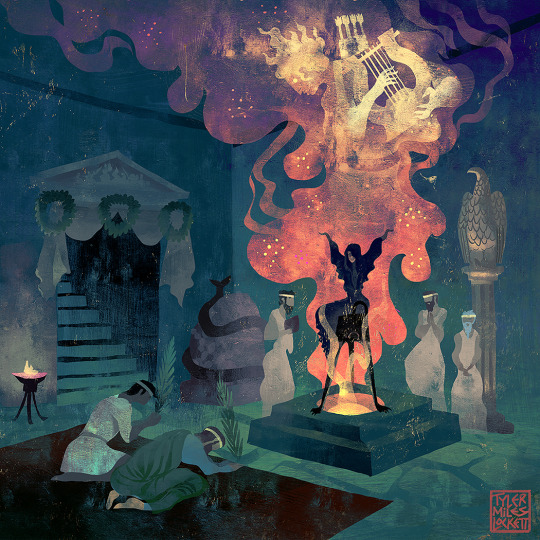
Theseus #1 - "Pythia: Oracle of Delphi"
King Aegeus of Athens, still childless, travels to the Pythia oracle at Delphi for advice. The Pythia, ever famous for her enigmatic and ambiguous prophecies, tells him “Do not uncork the wineskin until you have reached Athens.”
Zeus, wanting to locate the center of the world, released two eagles flying in opposite directions around the earth at equal speeds, and the birds reached one another at a specific point above the slope of Mount Parnassus. Here Zeus placed a sacred stone called the Omphalus, or “naval of the earth.” A serpent, Pytho (son of Gaia) guarded the stone, until Apollo came and slew the creature, establishing the site as a divine source for receiving messages directly from the god of prophecy.
Before entering the temple, priestesses and pilgrims alike would wash themselves in the soul cleansing waters of the Castilian spring for purification. In a sacred, inner sanctum, the Pythia, (head oracle priestess) was said to sit upon a tripod and breath in toxic vapors (said to be toxic fumes from Pythos rotting body) from a chasm below in the cave rock. The fumes could have been methane or ethylene, while others have theorized, she chewed or inhaled smoke from Oleander leaves. The priestess then fell into a trance, and receiving divine inspiration from Apollo, spoke in tongues that was interpreted and translated by priests into dactylic hexameter (the poetic meter used in ancient Greek epics like the Iliad.)
The Delphi site was sprawling and complex; holding the religious temple of Apollo, a stadium and gymnasium for the Pythian games, an outdoor theatre, a hippodrome for chariot races, among others. There were three philosophical phrases carved into the temple known as the “Delphic Maxims.” They were; “know thyself,” “Nothing in Excess,” and “Surety Brings Ruin.”
Like this art? It will be in my illustrated book with over 130 other full page illustrations coming in Aug/Sept to kickstarter. to get unseen free hi-hes art subscribe to my email newsletter
Follow my backerkit kickstarter notification page.
Thank you for supporting independent artists! 🤘❤️🏛😁
#theseus#pythia#oracle#delphi#oracleofdelphi#greekmythology#greekgods#pjo#mythology#classics#classicscommunity#myths#ancientgreece
78 notes
·
View notes
Text
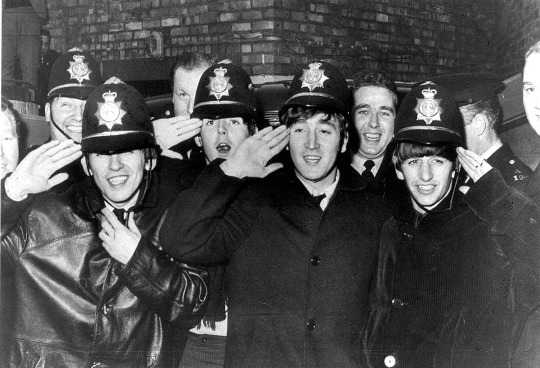
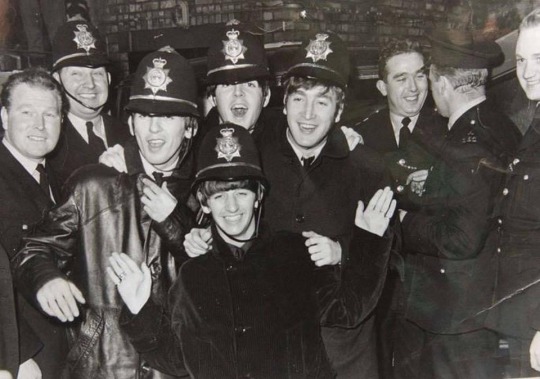
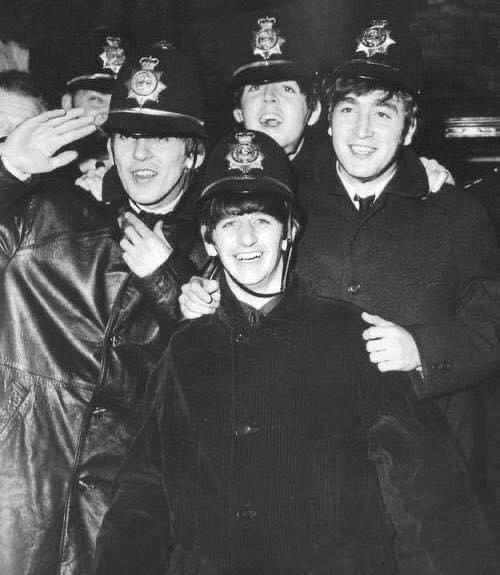
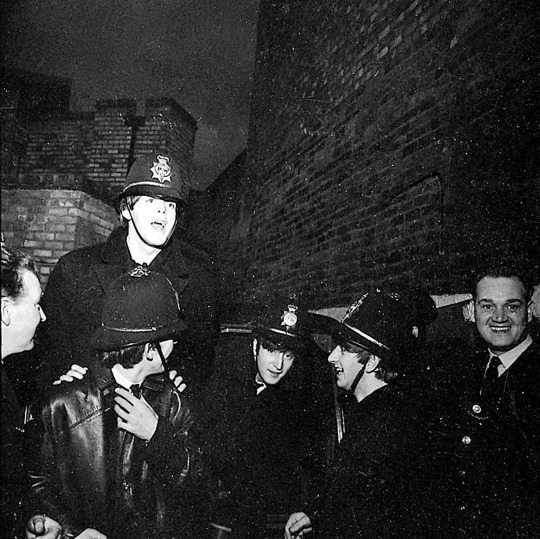
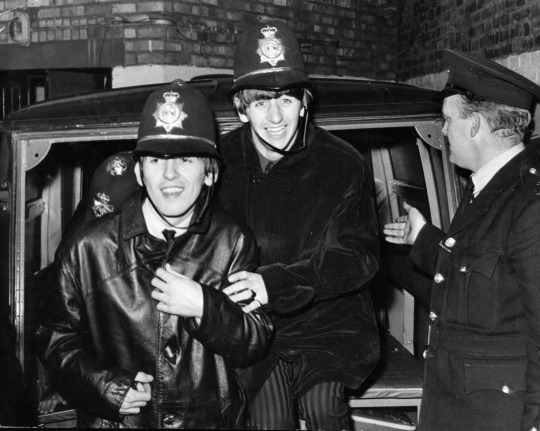
The Beatles pose with officers from West Midlands Police after arriving at the Hippodrome Theatre in Birmingham in a police van, 10th November 1963
#completed unrelated to paul getting sick two days later#it was sixty years ago today#november 1963 was just the best month#november 1963#john lennon#paul mccartney#george harrison#ringo starr#the beatles
203 notes
·
View notes
Text

January, 1923 Producer David Frohman, Natacha Rambova, Blanche Bates, Nora Bayes and Rudolph Valentino. Natacha and Rudy were in NYC where they appeared at the Century Theatre and the Hippodrome charity performances. From Silents, Please!, FB.
38 notes
·
View notes
Text
lmao guess whos activated ✨blathering oaf mode✨ again (clue: its me)
(cut because length and spoilers, read at your own peril)
so this post got me spiralling into detective mode again and yes i know douglas suggesting it might have been war/pollution but i have certified trust issues™ and i dont believe that for one darn second
BUT
i also don't think it's a kiss. lemme explain horrifically
so i took another look at the two frames we have of The Leaked Smooch™ and the background has a lot to be desired (if you take into account that the boys are taking up most of the frame (duh), plus already fairly average quality video PLUS compression from when i captured it)
but i think we can safely rule out that The Leaked Smooch™ doesn't happen in the theatre here, mainly because even though the quality is bad, the glasses in the Smooch™ are crowley's modern ones, not the ones we saw him wear in the 1941 flashback in s1, plus his hair is differently styled... so yes can pretty confidently say this is not the kiss we are looking for
so i wanted to pinpoint what era the theatre bit is actually set in, and therefore i set about identifying the theatre in question. turns out kids that im not a good researcher (despite it literally being my job) so it took FUCKING AGES but i eventually found set photos of the boys entering a theatre, specifically the hippodrome in bo'ness:

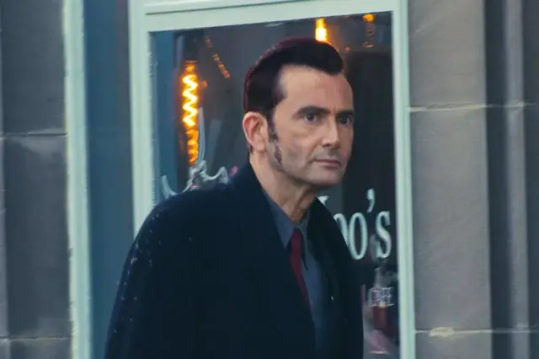
now this was a turn-up for the books, because that's crowley's 1941 costume right??? id recognise that iconic fit anywhere. az's costume is trickier to pinpoint bc he wears the same damn thing but pretty sure this is a match to the church scene:
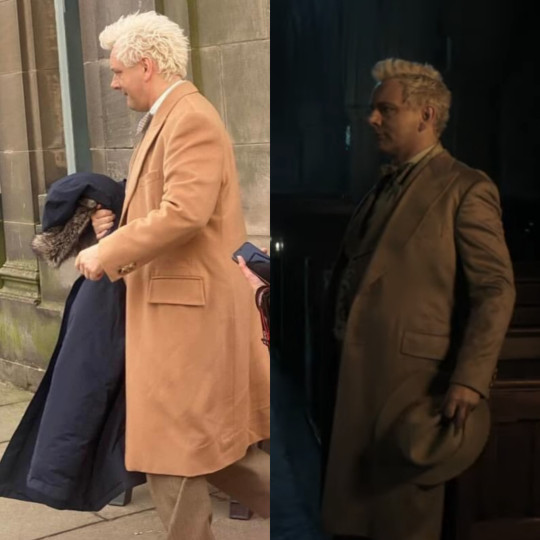
so we know from s1 that we have the church scene yada yada, and crowley offers aziraphale a lift home... which we know he accepts given that the s2 trailer gives us the ✨Dinner of '41✨ scene:

the other bit however to this puzzle is that there ALSO a set pic of aziraphale at the hippodrome in his magician's outfit. given the frame from the trailer where he looks like he's about to brick it going on stage, surrounded by lovely burlesque girlies and dame siân phillips in period dress, AND there were extras on the set dressed in ww2-type army uniforms, so i think it can be fairly surmised that this bit also occurs in the 40s

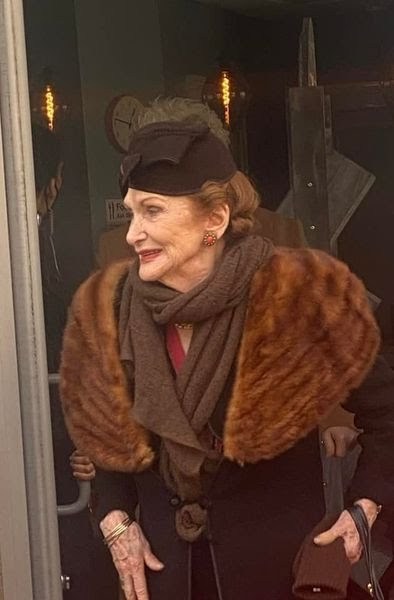


so my thought process is that we're getting two separate scenes (kinda) from the 40s, we have the church bit from s1 plus the Dinner of '41 scene as its own entity, but then, like
aziraphale is doing his magic act as a side hustle to this burlesque show? and crowley turns up to watch him, hiding out up in the box?
if we follow this completely made up narrative ive just come up with, aziraphale, im assuming, finishes up and gets changed into his normal clothes, and then goes up to this box to meet crowley?
to this end, i captured and slowed down the bit in the opening sequence where aziraphale and crowley (sorry douglas, not buying it) are in the box... and-
now to my eye, the motion of them in the clip looks like they are dancing? i don't have the source to hand but we've had it confirmed that a choreographer was brought into s2, not impossible az would go up to meet crowley after his magic act, whilst there's still something going on on the stage, and the two end up dancing or something? and az bless his heart gets spooked from that?
im reasonably convinced that this might be the origin of the 'you go too fast for me' line - something happens and ultimately aziraphale gets spooked given that he's only just realised he has Feelings for crowley, and so my boy fucking legs it (a lil post i made a while ago about this exact scenario if you'd care to peruse)
other thing to note:
there is a figure that is lurking behind aziraphale and crowley in the box, which looks like it moves specifically in sync with crowley, so it could be a shadow, or someone/thing is in the box that they aren't aware of 👀 so maybe this thing (?) witnesses it all? whatever went down in the box?
so in my addled feral mind, ive come up with a speculation that even as im breathing life into it sounds unhinged and so implausible it's hilarious -
i put to you, members of the jury, that something was meant to happen in that box, and it didn't... that something being that crowley makes a move of some kind - kiss, dance, hug, declaration, WHATEVER - and aziraphale was meant to accept it/reciprocate/idk, but didn't.
and that fucks with the plan, and for lack of better terminology creates a nexus event (lmao thanks loki) which in turns starts screwing with other events, somewhat like i theorised in this post here tehe
are aziraphale and crowley, essentially, the earth's endgame? idk about u but ive read enough angst fics to know that it's not inconceivable that crowley and aziraphale's mere existence may have been part of god's plan to represent free will on earth, defend humankind, and give balance and meaning to it
so what would happen if aziraphale essentially rejected that? did the most human thing possible and resisted the plan? idk i feel at this point i am just writing a fic and this will all be ludicrously incorrect bUT half the fun is torturing yourself over your own theories right 🙃
#good omens#good omens season 2#the more i speculate the more i come up with THE MOST bullshit theories#but i just feel like i need posts like this for posterity's sake just in case there was truth in the madness#but be warned kids if you gaze into the abyss the abyss also gazes into you#my god i SO HOPE that the two figures are literally not az or crowley bc that would be the funniest scenario#all this bullshit and for what? NOTHING#good omens speculation#good omens spoilers
75 notes
·
View notes
Photo

Scan - George Harrison having his palm read by Eva Petulengro, backstage at the Hippodrome Theatre in Brighton, October 25, 1964. Photo by Leslie Bryce/The Beatles Book.
“George Harrison comes in first. He is bigger than I had imagined and puts me at ease straight away with his pleasant smile and down-to-earth manner. But what will his hand show? I can’t wait to see. George gestures for me to sit down and eagerly holds out his hands towards me. ‘I’ve never had me hand read before. I’ve always been curious, though,’ he exclaims. He raises an eyebrow and looks at me expectantly. He has very strong lines on his hands and I hear myself telling him that he will branch out into other things. The sensible side of me finds it difficult to believe that someone in the most famous band in the world would not stay doing this forever, but I will always tell a client what I see and not just what they want or expect to hear. His hands are well worn and I find him to be a soft and gentle man who speaks quietly and has great respect for what I do for a living. His interest in all things psychic seems to be a passion and I tell him this is something he should persue. After half an hour, I complete my reading and we say our goodbyes.” - Eva Petulengro, The Girl In The Painted Caravan (x)
#George Harrison#quote#quotes about George#harrisonarchive scans#1964#1960s#The Beatles#fits queue like a glove
239 notes
·
View notes
Text
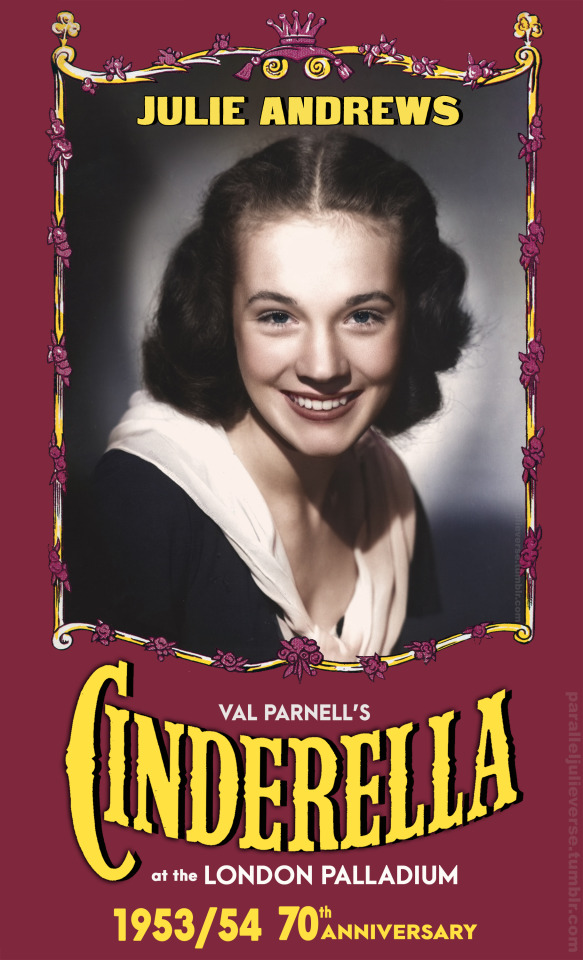
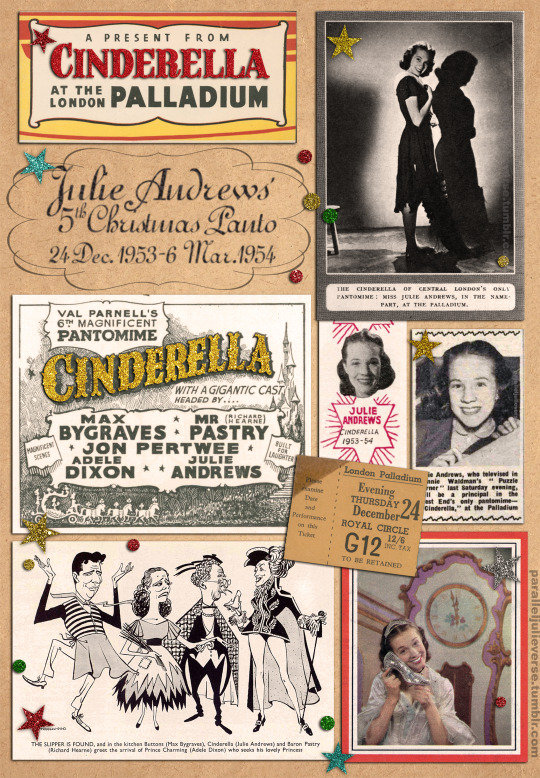
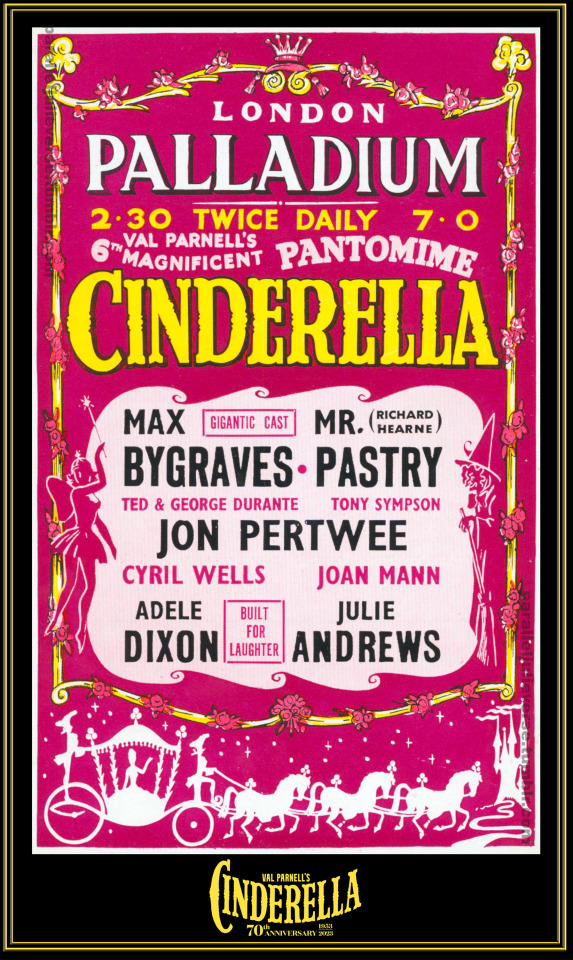

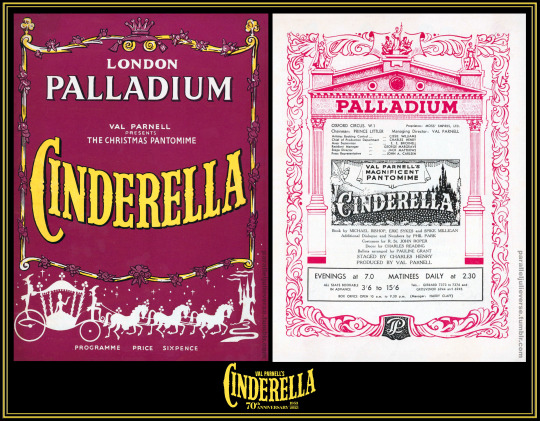

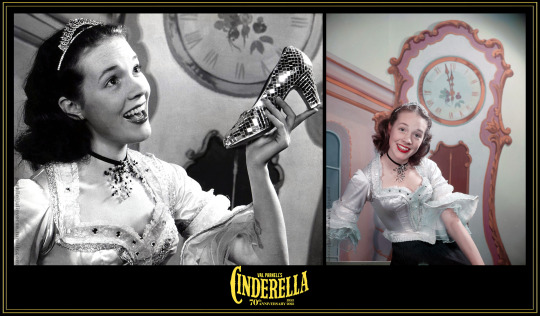

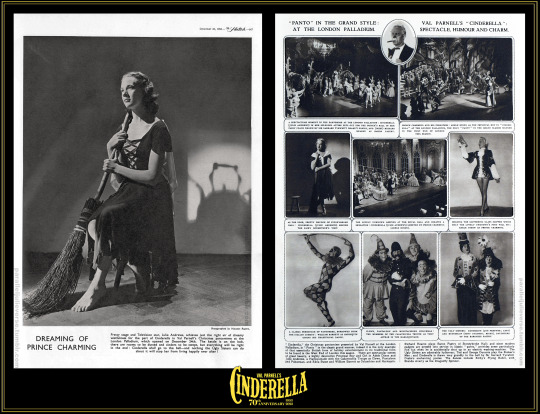




70th anniversary of Cinderella
London Palladium, 122 performances
(24 December 1953 - 6 March 1954)
This month marks the 70th anniversary of a milestone in the early career of Julie Andrews: the opening of Val Parnell's lavish Christmas pantomime, Cinderella, at the London Palladium on 24 December 1953.
Cinderella would be Julie’s fifth and final UK pantomime, following earlier runs in Humpty Dumpty (1948), Red Riding Hood (1950) Aladdin (1951), and Jack and the Beanstalk (1952). It was the biggest theatrical production Julie had yet undertaken and it would prove a turning point in the young star's career.
'No Pigtails for Julie'
By 1953, Julie was turning 18 and fast outgrowing the "infant prodigy" label of her early career. Efforts had been made for some time to update Julie's star image with a more mature look and an expanded musical repertoire. Much was made in the press about the new "[g]rown up now (or almost) Julie Andrews" (Bendle 1953: 2). "The tiny pigtailed schoolgirl who at age 13 sang in a Royal Command Performance," remarked one newspaper commentator, "is now a long-limbed attractive young lady who is wearing her first strapless dresses" (Pearce 1954: 6).
As an archetypal tale of girl-to-woman metamorphosis, Cinderella was an ideal vehicle with which to advance these transformative ambitions. It not only gave Julie titular 'principal girl' status, but called on her to assume a role of emotional nuance and adult sophistication.
Even Julie's mother, Barbara, is reported to have exclaimed:
“Julie, this is the perfect part for you at the perfect age. It couldn’t have come at a better time in your career" (Andrews 2008: 156-57).
Val Parnell presents...
Underscoring the significance of Cinderella was the fact it was a Val Parnell production. Dubbed 'Britain's Mr. Show Business', Parnell was a hugely influential impresario who dominated the British entertainment scene for many decades. He had started in provincial variety management before progressively rising up the ranks to assume control of the prestigious Moss Empires theatre chain (Bullar & Evans 1950: 219). Later, Parnell would go on to play a significant role in the expansion of the British television industry as General Manager of ATV, the first commercial television network in the United Kingdom (Sendall 1982: 250).
Renowned for his astute promotion of new talent, Parnell had been instrumental in launching Julie's career when he cast her in her first professional show at just 12 years of age: the now legendary Starlight Roof at the London Hippodrome in 1947/48 (Alldridge 1954: 1). Cinderella would bring the two together again for the first time in six years. To hear Parnell tell the story, it was a reunion long in the making.
"From the moment [I] first heard her sing," he declared, I "made a mental note that one day [I] was going to present Julie Andrews as Cinderella." As he explained:
"So many child performers are inclined to be precocious...But Julie was not. She had that appealing simplicity which she still retains. It struck me at the time that she had all the qualities of an ideal Cinderella -- youth. freshness, charm" (Lanchbery 1954: 1).
At the London Palladium
Of all the theatres managed by Parnell, none was more celebrated than the London Palladium, a 2200 seat theatre noted for its opulent architecture and state-of-the-art stage facilities (Woodward 2009). Parnell's adept leadership propelled the Palladium to international acclaim as the most famous variety theatre in the world and a top drawcard for international stars. "To appear at the Palladium is the goal to which every artist strives," noted a 1957 newspaper commentary, "to appear at the Palladium is to have achieved star status!" (Hoddinott 1957: 4).
The Palladium was also an important venue for Christmas pantomimes. Under Parnell, the Palladium "became the home of spectacular pantomime" with audiences eagerly anticipating each year's offering (Baker 2014: 219). Parnell applied the same triumphant formula to the humble British panto that he used in his variety revues: a blend of star power, spectacle, and money.
Writing in 1952, Ian Beven chronicled Parnell's studied approach to his annual pantomime at the Palladium:
"Each year...Parnell has tried to produce something bigger and better than the year before...He starts in midsummer, with a bare stage. By the third week in December, he has spent about £25,000 on scenery, costumes, musical arrangements, script, and rehearsals...Running costs of the show are high, as Parnell is prodigal with talent and fills his stage with people, and there are only about 140 performances on which to make a profit; but there is no disguising the fact that pantomime in this manner is a highly remunerative proposition, for there is rarely an empty seat throughout the run" (Seven 1952: 223).
Val Parnell's Magnificent 'Cinderella'
Cinderella would be Parnell's sixth pantomime at the Palladium. It would also be the only fully-staged panto in the West End for the 1953 Christmas season. In a sign of the rapidly changing post-war theatre scene, most of the other major London houses were tied up with long-running musicals and plays, largely imported from America. In addition, arena-style ice spectaculars were increasingly in vogue with a slew of new-fangled pantos "on ice" scheduled for suburban venues, leading some wags to quip that Parnell should call his show "Cinderella on Wood" ('Old fashioned Val' 1953: 6).
While many lamented it as a sign of "the decline and fall of the honoured institution" of the traditional panto, the absence of competition gave Parnell a distinct commercial advantage ('At the Pantomime', 1954: 4). When pre-sales for Cinderella opened in the autumn of 1953, the booking office was inundated and the show would become the theatre's most successful pantomime to date (Alldridge 1954: 4).
It also spoke to Parnell's innate sense of theatrical traditionalism. Though he was certainly not averse to innovation and was quick to adopt state-of-the-art technologies, Parnell was a producer of the old school. He believed in sticking to the tried-and-true and giving audiences what they expected. "Audiences haven't changed at all," he opined, "Certainly not the Palladium audiences. It's the same as it ever was. People go the the theatre to enjoy themselves...My job is to give it to them in bigger and better shows" (Hoddinott, 1957: 4)
True to this crowd-pleasing philosophy, Parnell determined to make Cinderella his most spectacular panto yet. Planning for the show started early in 1953. "I always start pantomime with a bare stage," he declared, "Everything must be new" (Fagence 1958: 4). Heading the production team were two influential figures who were something of righthand men to Parnell: Charles Henry and Charles Reading.
Henry was Chief of Production at the Moss Empire chain for over thirty years. During his tenure, he would produce over 200 revues and pantomimes, as well as fourteen Royal Command Performances (Born & Frame 1960: 4; 'Charles Henry' 1959: 1). Known as a canny talent-spotter with an encyclopaedic memory -- Bud Flanagan famously called him "a blinking card index of comedy" -- Henry was fondly remembered by Parnell at his passing in 1968 as "one of the theatre's greatest backroom boys" and "my closest associate" (Evening Standard Reporter 1968: 17).
Reading was an equally trusted majordomo for Parnell. A true theatre polymath, Reading trained as an actor before expanding into production, direction, writing, and design. It was the latter talent that brought Reading initial fame with a series of innovative opera and ballet designs for Sadler's Wells and the Old Vic. He subsequently moved into designing more commercial fare in the West End and, in 1947, was contracted by Parnell as resident designer and production assistant at the Palladium (Barker 199: 20; Vallance 199: 36).
Together Parnell, Henry, and Reading set about staging Cinderella as an unparalleled spectacular. Set and costume design alone was budgeted at over £20,000, which equates to almost £700,000 in today's money (Webster 2013). Reading designed an intricate series of progressively spectacular sets, including a palatial Ballroom, a Cave of Crystal Lustres, and a Palace of Porcelain for the grand finale (V&A 2015).
Famed stage couturier, Robert St John-Roper, designed a complementary suite of costumes including a dazzling ballgown and bejewelled wedding dress for Julie. In her 2008 memoir, Julie recalled the breathtaking splendour of it all:
"Everything about that 1953/1954 production of Cinderella had a certain elegance...The production values on the show were terrific; there were revolving stages, and real white ponies pulling the spectacularly gilded coach...In the grand finale wedding sequence, my crinoline was so huge that I had to arrive backstage dressed in my bodice, sleeves, and petticoat, and walk into the crinoline skirt, which was braced on a stand because it was so bejewelled and cumbersome. The company, Prince Charming, and I were brought up from below stage on a hydraulic elevator, to be revealed in a sparkling white set and costumes for the final tableau" (Andrews 2008: 155-57).
Spectacle, Humour, and Charm
Careful attention was equally paid to the other production elements of Cinderella to ensure a well-wrought work of quality theatrical entertainment. To write the script, Parnell commissioned a trio of talented young writers who were only then beginning to make a name for themselves but who would go on to become giants of British comedy: Eric Sykes, Spike Milligan, and Mike Bishop. Their original treatment hewed closely to the core elements of the well-known fairy story but embroidered with innovations and, true to panto style, comic flourishes.
In the Sykes et al script, the story opens with Baron Pastry of Stoneybroke Hall lamenting that he has fallen on hard times (Stoneybroke...get it?!). He lives with his beloved daughter, Cinderella, and their faithful but hopeless retainer, Buttons who carries an unrequited flame for Cinderella. The Baron announces he has just married a wealthy widow in the vain hope of restoring his fortune. She comes to the Hall with her two unloved and unlovable daughters -- the Ugly Stepsisters, of course -- and they set about making Cinderella's life a misery. The requisite Royal Ball, benevolent Fairy Godmother, and Glass Slipper hunt all ensue before the inevitable happily-ever-after ending (Sykes et al. 1953).
Woven around these well-worn plot points were a series of comic interludes designed to accomodate the pantomime conventions of audience participation and novelty acts. These ran the gamut from a demonic door and a bomb-toting spaceman ("it's behind you") to jive singing footmen and a giant electric washing machine that tumbled a hapless Baron Pastry along with an assortment of oversized clothes (Sykes et al. 1953).
Song and Dance
No pantomime would be complete without music and dance and Cinderella served both in abundance. Overseeing the musical side of things were another pair of Palladium panto stalwarts: Phil Park and Bobby Howell.
Park had been a star cinema organist during the picture palace era but, following the war, he turned his attention to composing and arranging. It was in this capacity that Park worked frequently for Parnell on his Palladium pantos which he "tailored to the stars appearing in the shows but always preserved the time-honoured tradition" ('Obituary: Phil Park' 1978: 6).
Bobby (aka Bobbie) Howell was a prominent band leader of the inter-war years, touring the cinema and dance circuits. After the Second World War, he became a musical director in the West End, working on a string of successful shows such as Strike a New Note, The Lisbon Story, and Piccadilly Hayride. He also worked as musical director and conductor on many of Parnell's pantomimes, including Cinderella ('Bobby Howell' 1962: 3).
In crafting the musical score for Cinderella, Park and Howell followed typical pantomime form of mixing existing well-known tunes with bespoke compositions. Many of the latter were written by Park including a humorous duet between Cinderella and Buttons (played by Max Bygraves). In this duet, Cinderella fantasises about a romantic future with the Prince, while Buttons humorously interjects with sardonic quips:
Cinders: There's a lady -- and she curtseys,
Who she is, I cannot guess.
She might be me, except that she
Has such a pretty dress.
And there's her handsome partner,
Who is he, do you suppose?
Buttons: All I see's a turkey,
With a whopping parson's nose!
Cinders: Now I see him very clearly,
With a smile upon his face;
I'm certain he's a Prince,
Because he bows with royal grace.
See now he takes her hand,
And lifts it gently to his lips!
Buttons: He looks like George Dawson,
With a plate of fish and chips!
In addition to the duets, Julie had two showcase solos in Cinderella: "Chasing Shadows", a 1935 torch song by Silver and Davis, and "Is it Any Wonder," a lilting pop ballad by Bob Hayes and Roy Rodde which had been a recent chart hit for Joni James.
Interestingly, both solos were modern pop standards and, thus, a marked departure from the light classical repertoire that had been Julie's stock-in-trade. She did get to do some limited coloratura trilling in the extended Transformation Scene at the climax of Act 1 where Strauss waltzes formed the musical accompaniment, but the strong emphasis on popular tunes was indicative of the strategic shift in Julie's image mentioned earlier.
A number of reviewers remarked that Julie didn't seem to do as much singing in Cinderella as they were expecting. She did, however, compensate with quite a bit of dancing -- more dancing in fact than she'd ever done in a professional context.
Not only was there the mandatory waltz with the Prince, but Julie had a solo dance early in Act 1. She was also a key part of the pre-intermission ballet sequence. Choreography for Cinderella was provided by Pauline Grant with whom Julie had worked so happily the previous year in Jack and the Beanstalk. Pre-show publicity photos showcased Julie's dance rehearsals with Grant, underscoring her now mature lithe figure and womanly style.
A Who’s Who of Cinderella
Alongside Julie, the cast of Cinderella was a roster of star names and variety notables:
Max Bygraves as Buttons: Born in 1922 in London, Bygraves was a versatile entertainer known for his Cockney persona, humorous storytelling, and sentimental singing. His endearing catchphrases and relaxed chummy style made him a beloved figure in British entertainment. Growing up in a modest family, he showed early signs of showmanship, encouraged by his prizefighter father. Bygraves left school at 14 and served in the RAF during WWII, where he began entertaining troops. His career took off post-war with various stage and radio appearances, including Educating Archie where he first performed alongside Julie. He made several films in the 1950s and his recordings, often nostalgic or comedic, were hugely popular. He continued performing internationally for many years, eventually settling in Australia. Recognised for his contribution to entertainment, he was awarded an OBE in 1982. He passed away in 2012 (Leigh 2012: 37).
Richard Hearne as Baron Pastry: Born in Norwich in 1909, Hearne came from a family with deep roots in music hall and circus arts, and he started performing on stage as a child. Hearne's career in variety and revue culminated in the creation of the beloved Mr. Pastry, a bowler-hatted, walrus-moustached character that brought him success in West End shows, pantomime, and TV, both in the UK and internationally. His role in Cinderella was effectively an adaptation of Mr Pastry complete with his signature comic dance, "The Lancers". A dedicated philanthropist, Hearne was a very active supporter of handicapped children and was honoured with an OBE in 1970 for his charity work. He passed away in 1979 ('Obituary: Richard Hearne', 1979: 27).
Adele Dixon as Prince Charming: Born in South London in 1908, Adele Dixon was a versatile performer known for her roles in London and Broadway musicals, Palladium pantomimes, and Shakespearean plays. After training at the Italia Conti Academy and the Royal Academy of Dramatic Art, she joined the Old Vic company. There, she shone in roles like Juliet and Ophelia. Dixon's transition to musical comedy in the 1930s made her a celebrated figure in the West End, admired for her red-gold hair, expressive brown eyes, and clear soprano voice. Her noteworthy performances included leading roles in Lucky Break, Anything Goes, and Over She Goes. Additionally, she appeared in the film Calling the Tune and became the first female performer on BBC Television in 1936. Dixon continued her success in post-war years with major hits like The Fleet's Lit Up and All Clear. She was also highly acclaimed as a Principal Boy in pantomimes, performing in these trouser roles 14 times throughout her career. Her portrayal of Prince Charming in the 1953 production of Cinderella marked her last appearance on the West End stage. While she continued to perform in provincial roles, health issues forced her into early retirement in the late 1950s. Dixon passed away in 1992 (Thornton, 1992: 29).
Joan Mann as Dandini: Welsh-born Mann trained as a dancer and started touring the variety circuit in her teens where she appeared on bills with stars including Max Miller and Tommy Trinder. A tall attractive brunette with a pleasant voice and shapely dancer’s legs, Mann was a perfect pantomime boy. She played opposite Julie in Jack and the Beanstalk (1952) and also toured with her as part of the musical revue, ‘Cap and Belles’ in 1953 (Andrews 2008: 146). Though she wasn't Principal Boy in Cinderella, Mann played the other leading pants role of Dandini, the Prince's Squire. Mann’s greatest fame came later as part of the celebrated Fols-de-Rols variety troupe with whom she performed for almost two decades. She also starred opposite Dame Anna Neagle in the hit West End musical, Charlie Girl in the late-1960s. Mann died in 2007 aged 87 (P.N., 2007: 53).
Jon Pertwee as Buttercup: Born in 1919, Pertwee was a versatile actor who left a significant mark in television, radio, theatre, and film. Educated at Sherborne, he belonged to a family of distinguished artists and made his acting debut in 1939 in Brighton. His notable wartime service on the HMS Hood led to a fruitful collaboration with Eric Barker in comedy writing and radio. Pertwee became a household name with his long-running role in the BBC radio series, The Navy Lark. He gained even greater international fame on television as the third Doctor Who from 1970 to 1975, and as Worzel Gummidge. Pertwee's career spanned over 100 films, including two Carry On movies, and numerous stage productions. In Cinderella, Pertwee took on the comic drag role of Buttercup, one of the Ugly Sisters. Pertwee passed away in 1996, leaving a legacy as a unique and memorable actor (Newley, 1996: 38).
Tony Sympson as Dandelion: Born in East London in 1907, Tony Sympson had a dynamic career in music and theatre. Initially trained as a choral scholar at St Clement Danes Church Strand, he made his stage debut as a specialty dancer in Dear Love. A mainstay character actor in West End theatre, he appeared in plays, musicals, revues, pantomimes, and operas. Sympson also featured in television ads where he earned a reputation for well-conceived characterisations. A pantomime regular, Sympson played the second of the Ugly Sisters, Dandelion, in Cinderella, a role he would repeat in subsequent productions. Sympson died in 1983 at the age of seventy-six (Marriott, 1983: 7).
Cyril Wells as Baroness Pastry: Born in Belfast in 1907, Wells' entry into acting was fortuitous. Initially a bank clerk, his passion for dancing led him to become a rehearsal partner for actress Jessie Matthews. This collaboration resulted in Wells being cast as her dance partner in the 1936 film It's Love Again, his only appearance on screen but a stepping stone into show business. He then featured in West End musical comedies like Order to View (1938), Here's Looking at Them (1939), and The Charcoal-Burner's Son (1939). Post-war, Wells shifted to comic roles in theatre and variety, notably in pantomime. In Cinderella, he played the Dame role of the blue-wigged Baroness. Wells passed away in 1958 in Southport, Lancashire ('Obituary: Cyril Wells', 1958: 9).
Ted and George Durante as the Broker's Men: One of several novelty acts to appear in Cinderella, the Durantes were a popular acrobat comic duo who found popularity on the post-war variety circuit. Contrary to their billing as brothers, the duo actually comprised two unrelated individuals, Ted Aston and George Mooney. They met in 1946 while performing as part of an acrobatic troupe and decided to branch out as partners, adopting the Durante surname at random. Their act ran for nine years till the late-1950s when Ted married and formed a new double act with his wife, becoming 'Ted and Hilda Durante'. This husband-and-wife team continued for many decades, becaming regulars on TV variety shows in the sixties and seventies (Wilmut, 1985: 182).
Elaine Garreau as the Godmother: Anglo-French actor Garreau, born in 1903, had an extensive and diverse career in British theatre, film, and television. She trained as a dancer, starting on the London stage at age 11 with a company of child artists. At 16, she was principal dancer at the Théâtre des Ambassadeurs in Paris and, at 20, understudy to the legendary Mistinguett. Returning to the UK, Garreau transitioned to acting and performed for many years in various London and provincial troupes across drama, comedy and musicals. Throughout the 40s and 50s, Garreau appeared frequently in pantomimes. In Cinderella, she took on the role of the magical Fairy Godmother. A few years later in 1958, Garreau would play again opposite Julie as part of the original London production of My Fair Lady, in the role of Lady Boxington. Garreau would remain with the show for over 10 years in both the Drury Lane and touring productions, racking up over 3,000 performances which was a world record. In her later career, Garreau increasingly appeared as a character actor in film and television. Garreau died in 2000 at the grand age of 97.
Silvia Ashmole as the Fairy Queen: Born in 1926, Ashmole enjoyed an idyllic childhood, travelling through Europe with her affluent parents and attending Cheltenham Ladies College. A trip with her mother to the ballet in London inspired Ashmole to take dancing lessons and, at age 16, she enrolled in the Cone-Ripman School of Dance, where she quickly excelled. Soon thereafter she secured a place in the coveted Royal Ballet (Sadler's Wells) and toured with them for several years. During a season at Glyndebourne, she met and eventually married the renowned Anglo-German opera director Peter Ebert. Ashmole continued her career as a dancer, often performing in operas at Glyndebourne and Edinburgh. She also worked frequently with choreographer Pauline Grant who contracted her to appear as the Fairy Queen in Cinderella (Wigglesworth 2018).
The Casavecchia Troupe as the Clowns: Billed as the "World's Greatest Comedy Tumblers," the Casavecchia Troupe was a team of acrobats who had worked individually in circus and variety before combining their talents. They toured widely in the UK variety circuit during the late-40s and early-50s. In Cinderella, they appeared as part of the Harlequinade sequence where their slapstick routine offered well-received comic relief.
William Barrett and Edna Busse as Harlequin and Columbine: Barrett and Busse were a pair of classically trained ballet dancers who danced the classic roles of Harlequin and Columbine in the Act 1 Harlequinade. Barrett was born in 1919 in Staffordshire and joined the Sadler's Wells Ballet company in the late-40s, touring with them to the US ('From Farm' 1954: 11). In the 60s and 70s, he performed in theatre and TV as a resident member of the Black and White Minstrel Show. He later retrained as a drama teacher and passed in 1995 (Jevons 1995: 29). Edna Busse was born in Melbourne in 1918. A protégé of Edouard Borovansky, she later honed her skills in London with Mathilde Kschessinska. Returning to Australia, she continued to perform, before transitioning into a revered ballet teacher. She passed in 2019, aged 100 (Yeo 2019).
The Aida Foster Babes: One of many companies of dancing juveniles popular in the era, the Aida Foster Babes were students of the Aida Foster Academy in Golders Green, London. Established in 1929, the Academy trained several generations of young hopefuls till ists closure in 1970, including several famous alumni such as Jean Simmons and Barbara Windsor ('End' 1970: 43). For Cinderella, Foster provided a group of 12 ‘babes’ who performed in several of the show’s lavish dance sequences.
Critical and Popular Reception
Cinderella was very well received by audiences and critics alike. The following excerpts give a sense of the uniformly glowing notices earned by the show, with particular mention of Julie:
Daily News: "Mr. Val Parnell has really done us proud. There can hardly be two more endearing comics than Max Bygraves and Richard Hearne. Julie Andrews, less operatic than I would have expected, is just the girl for Cinders, and she dances gracefully...a most spiffing pantomime" (E.F. 1953: 4).
The Tatler: "Cinderella has taste, beauty and elegance...But if there is more spectacle than of other good things who will complain, since the result...is so giddily splendiferous. The lighting and the costumes and the scenery could not better done...The principals are worthy of their splendiferous surroundings. Miss Adele Dixon has the right princely strut and Miss Julie Andrews, though she is less vocal than she was expected to be, makes Cinderella a young lady of character and charm" (Cookman 1954: 10).
Daily Mail: "Star names may shine all over the programme -- Max Bygraves and Richard Hearne here; Adele Dixon and Julie Andrews there -- but spectacle is the real star of Val Parnell's typically sumptuous pantomime. Instead of scuffling through the usual sleight-of-stagehand transformation scene Cinderella escapes from the kitchen by way of magic force, fairy spinning wheel, and luminous flying ballet to the cave of crystal lustres: a silvery-white vision as glittering as a wedding cake brush to life" (Wilson 1953: 4).
The Guardian: "Pantomime, though represented only by a single Cinderella in Central London, still flourishes...Cinders (Julie Andrews) croons before the dying kitchen fire...Max Bygraves and Richard Hearne use routine 'biz' to good effect...But what is really remarkable and characteristic of Pantomime 1953 is the standard of the ballet: the scene before Cinders goes off in her glittering coach is as smart, fast, extravagant and excitingly danced as a finale at the Moscow Opera" (F.B. 1953: 3).
The Observer: "The new Palladium Cinderella is magnificent to the eve and its Transformation Scene has fine taste as well as sumptuosity...Julie Andrews is a most attractive Cinderella but not so vocal as I expected" (Brown 1953: 6).
Daily Telegraph: "Cinderella...is up to the best Palladium standard. Elaborate spectacle and attractive dancing combine to delight one's eye. Adele Dixon is an admirable Prince Charming -- she has always been able to fill a big stage with her personality -- and Julie Andrews, kept oddly short of chances to sing, makes Cinderella a young lady of character and charm" (Darlington 1953: 7).
The People: "This is a grand and glamorous show with Julie Andrews as Cinderella. But it would have been grander still had they let her sing more. Adele Dixon constantly charms as the Prince. Max Bygraves and Richard Hearne provide a crescendo of laughs" (Shepherd 1953: 5).
The Times: "It is a hard fact for traditionalists to swallow that there is only one pantomime on the grand scale in the West End...yet if the dismayed traditionalists go the Palladium..., they will soon be cheered up....Here, it seems to say with complete confidence, is one of the few things in a changing world that have remained constant...The humour...is received with every sign of enjoyment and the romantic side of the show is from the first in good trim...Miss Adele Dixon and Miss Julie Andrews belong to the order of unobtrusively pleasant principles. They are an appealing pair, and they have in Mr. Max Bygraves an affable Buttons" ('The Palladium' 1953: 8).
The Stage: "Mr. Parnell has thrown everything into a demonstration of faith, assembling a director's dream of a cast and applying it to all the skill, experience and efficiency that have set the Palladium high in the world of entertainment. He lavishes talent and creative art, he employs every device of lighting, mechanical contrivance and novel effect that the theatre possesses, underlines it all with a defiant and traditional Harlequinade, and the result is the pantomime of pantomimes...Julie Andrews's fragile charm graces Cinderella's rags and raiments alike, and Adele Dixon's slim figure and are of intelligent humour are a delight" ('Christmas Shows' 1953: 5).
The Sketch: "It is the happiest panto-subject, and this is as happy a version as I remember. Richard Hearne in the bowels of a washing-machine, Adele Dixon and Julie Andrews to end rightly as Prince and Princess, Max Bygraves to chant 'Bighead!' -- here they all are, and Val Parnell has never had a spectacle more satisfying than the magical creation of coach and gown." (Trewin 1954: 18).
A Real-Life Cinderella
In many ways, Cinderella signalled something of a pinnacle for Julie's early British career. She was now a young woman in a starring role on the West End stage and, in professional terms, could scarcely go much further. Julie herself writes that "I felt that with Cinderella, my career had peaked" and whatever future she may have would be a continued cycle of "radio, vaudeville and pantomime" (Andrews 2008: 157).
But the theatre gods had other plans and a real-life Fairy Godmother materialised to change the course of Julie's life forever. Midway through the run of Cinderella, Julie was paid a backstage visit by Vida Hope, the producer of the smash hit London musical, The Boy Friend. There were plans to take the show to New York with a new company, but the producers were struggling to cast the lead role of Polly Browne. At the suggestion of Hattie Jacques, Julie's former co-star in Educating Archie, Hope went to see Julie in Cinderella and offered her the role.
It is part of theatrical lore that Julie was initially reluctant to accept the offer, but she was eventually persuaded to seize the opportunity (Andrews 2008: 157-58). Five months after the close of Cinderella, Julie flew off to New York and the rest, as they say, is history...
References:
Alldridge, John (1954). 'Oh, for another Gracie! says Mr Show Business.' Manchester Evening News. 12 October 1954: 1.
Andrews, Julie (2008). Home: A memoir of my early years. London: Weidenfeld and Nicolson.
'At the Pantomime.' (1953). Belfast Telegraph. 30 December: 4.
Baker, Richard Anthony (2005). British Music Hall : An Illustrated History. Stroud: Sutton.
Barker, Dennis. (1999). 'Obituary: Charles Reaaing.' The Guardian. 19 May: 20.
Bendle, Alan (1953). 'Keeping a Straight Bat on a Sticky Wicket.' Manchester Evening News. 15 August: 2.
Bevan, Ian (1952). Top of the Bill: The Story of the London Palladium. London: Frederick Muller Ltd.
'Bobby Howell.' (1962) The Stage and Television Today. 8 February: 3.
Brown, Ivor (1953). "At the Theatre: Not on Ice." The Observer. 27 December: 6.
Bullar, Guy R. & Evans, Len (1950). The Performer: Who's Who in Variety. London: The Performer Ltd.
Cameron, Don (1958). 'The Val Parnell Story Parts 1-4'. The :
Chanticleer (1953). 'People: Old Fashioned Val.' Daily Herald. 3 November: 6.
'Charles Henry Resigning.' (1959). The Stage. 2 April: 1.
'Christmas Shows: The Palladium "Cinderella'".' (1953). The Stage. 31 December: 5.
Cookman, Anthony (1954). 'At the Theatre: Cinderella (London Palladium).' The Tatler and Bystander. 6 January: 10.
Cottrell, John (1968). Julie Andrews: The Story of a Star. London: Arthur Barker.
Darlington, W.A. (1953). "Christmas Shows: Modern Twist to Cinderella, Elaborate Show at Palladium." Daily Telegraph. 28 December: 7.
Double, Oliver (2012). Britain Had Talent: A History of Variety Theatre. London: Palgrave MacMillan.
E.F. (1953). 'A Most Spiffing Pantomime." Daily News. 28 December: 4.
Even Standard Reporter. (1968). 'Ex-Palladium Showman Dies.' Evening Standard. 28 February: 17.
Fagence, Maurice (1958). 'Curtain Up on Mr. Palladium'. Daily Herald. 17 February: 4.
F.B. (1953). "From a Nose in Egypt to Abandon in the Outer Suburbs." The Guardian. 28 December: 3.
Frame, Colin & Boorn, Bill. (1960). 'Palladium Nights.' The Birmingham Evening Mail. 9 November: 6.
Hoddinott, Derek (1957). 'Val Parnell Speaks". The Stage. 29 August: 4.
Lanchbery, Edward (1954). 'Teen-age Cinderella task to the CN: Julie Andrews' dream comes true.' Children's Newspaper. 16 January: 1.
Leigh, Spencer (2012). 'Obituary: Max Bygraves.' The Independent. 3 September: 37
Marriott, R.B. (1983). 'Obituary: Tony Sympson'. The Stage and Television Today. 21 April: 7.
Newley, Patrick. (1996). 'Obituary: Jon Pertwee'. The Stage. 23 May: 38.
'Obituary: Cyril Wells' (1958). The Stage. 17 April: 9.
'Obituary: Phil Park' (1978). The Stage and Television Today. 23 November: 6.
'Obituary: Richard Hearne' (1979). The Stage and Television Today. 30 August: 27.
Pearce, Emery (1954). “No Pigtails for Julie.” Daily Herald. 11 January: 6.
P.N. (2007). ‘Obituary: Joan Mann’. The Stage. 6 December: 53.
Ray, Ted (1956). 'Palladium Nights.' The Liverpool Echo. 27 October: 3.
Sean, Neil (2014). Live from the London Palladium: The World's Most Famous Theatre in the Words of the Stars Who Have Played There. London: Amberley Publishing.
Shepherd, Ross (1953). "London Holiday Shows." The People. 28 December: 5.
Sykes, Eric; Milligan, Spike; Bishop, Michael; and, Park, Phil. (1953). Val Parnell's Cinderella: For production at the London Palladium Xmas 1953. Moss Empires Ltd. [Manuscript held in the Lord Chamberlain's Plays Collection, British Library].
"The Palladium: Cinderella." (1953). The Times. 28 December: 8.
Thornton, Michael. (1992). 'Obituary: Adele Dixon.' The Stage. 4 June: 29.
Trewin, C.W (1954). "At the Theatre: Cinderella (Palladium)." The Sketch. 13 January: 18.
V&A (2015). 'Charles Reading.' V&A Theatre and Performance Collection. https://collections.vam.ac.uk.
Vallance, Tom. (1999). 'Obituary: Charles Reading.' The Independent. 17 June: 36.
'Variety Stage: Palladium Plans' (1953). The Stage. 17 September: 3.
Webster, Ian (2013). 'U.K. Inflation Calculator.' In2013dollars.com. https://www.in2013dollars.com/UK-inflation.
Wilmut, Roger (1985). Kindly leave the stage! : the story of variety, 1919-1960. London: Methuen.
Wilson, Cecil (1953). "Spectacle gets the star role." Daily Mail. 28 December: 4.
Woodward, Chris (2009). The London Palladium: The Story of the Theatre and its Stars. Huddersfield: Northern Heritage Pub.
©2023, Brett Farmer. All rights reserved.
23 notes
·
View notes
Text
Good Omens Locations - S2 E4
Just the one that I've been able to recognise for this episode, though I know there are a couple of other locations in Edinburgh and I can't work out where they featured in the show.
The Windmill Theatre - this was filmed in the Bo'ness Hippodrome, one of the first purpose-built cinemas in Scotland.

40 notes
·
View notes
Text
London Adventure
Joseph Quinn & female y/n

Summary: Joseph and you have your second date at the Skygarden in London after what happened the night before…
Warnings: 18+ , slow burn and fluffy, it gets spicy soon!!
Part 4
Was that really your first kiss? Your first real date ended with your first kiss like this? The train arrived. You got in and immediately watched out for a seat. It was hard to stand, your legs were shaking. You caught yourself subtly licking over your lips. It tasted different than usual, like a mix of the burrito you had and the drink you ordered a few hours ago, except the fact that you weren´t the one who drank that drink. What did that kiss mean? He wanted to see you again. Tomorrow. Thursday, he said he would be busy on Thursday, now he wanted to see you again. The day after he kissed you. And just left. What the hell was going on. Your head felt kind of dizzy. A headache started to creep in. It was full with so many different thoughts, that you almost missed your station. When you got home all you were able to do was getting in your pj´s, remove your makeup and brush your teeth. The moment your head hit the pillow you fell asleep.
The next morning you woke up, got ready and went to work. Jen was already there and welcomed you in the room of your kids group with wide eyes. “OH MY GOD! Tell me everything about yesterday!!” You were totally confused and suddenly remembered what happened yesterday. “Oh Jen. I don´t know what is going on.” Jen chuckled: “What?” “It was amazing. I´ll see him again tonight”, you did not seem really content. That´s why Jen asked you: “So what is wrong, you don´t seem happy about it.” “I´m just confused…” There were no kids in the room yet, so you both took a seat on the sofa. “Okay, tell me more, y/n.” You took a deep breath: “We met at the hippodrome. He was late but he already apologized before over text message. It was a technical issue, with the train rails. We decided to go to seven dials market, the whole way he had my hand in his hand.” Jen gasped and grabbed your hand. “He did NOT! He´s touchy, uuuuuuh.” You both laughed. “Well, he is, always touching a hand, or my arm or my back when walking.” “Love that.” was Jens reaction. She started to focus again and looked at you with a lot of expectation. You continued: “We ate at seven dials market, we talked a lot. Then we…” Jen interrupted you: “What did you talk about?” “Everything!” Right now, you were just reliving everything before the confusing kiss. It was not like you didn´t like your date with him, it was your first freaking kiss, you weren´t even able to enjoy it, because you were too surprised. “We really talked about everything. Work, what kind of food we like, what we like to do in our free time, about his education, about my life in Germany…just everything.” “What is he doing for a living?”, Jen asked. “Ehm, he´s an actor.” “Really, what kind of acting?” You tried to keep this short: “BBC, theatre, Netflix. Then we-“ Jen was too curious about the acting thing: “What´s his name?” “Joseph Quinn.” Again, she gasped, this time she grabbed you by your shoulder: “No FUCKING way, y/n! You had a date with Joseph chocolate button eyes Quinn?!?” You giggled in confusion: “How do you know about the chocolate button eyes?” “He said that at a convention some years ago! I can´t believe you really went on a date with Joseph Quinn!!” she squeaked a little. “Well, he told me that his mother used to call him like that.” “Yes, I know, that’s what he said at the con, it was a video on tiktok! Oh my god, Joseph Quinn. He´s really a touchy guy” “Alright, this feels kind of weird now.”, you said to Jen: “What do you mean?” “Oh, there are a lot of videos on the internet, where he´s holding hands with fans, or rubbing their backs and everything.” Wow, that hit you like a car. Now it didn´t feel really special to you, the way he walked with you hand in hand, the sneaky little touches you got, when you sat for dinner. Your heart felt heavy, in a bad way. “Go on.” Jen interrupted your thoughts. “That´s it. I had to leave because of work, and we´ll meet tonight.” You didn´t know why, but you did not want to share the kiss with Jen. “Sounds promising!” Jen smiled at you, you tried to smile back. The first kid arrived so you had to get to work.
Shortly before lunch break, you actually considered to cancel your date with Joe tonight. You were overwhelmed and felt kind of sad about the things Jen told you. You took a seat at the resting room and got your phone out of your handbag, pretty sure to cancel right now. Maybe you could tell him you feel sick or whatever. Your heart skipped a beat, when you saw that you had got two messages from Joe. The first one was: “hi love, how are you?” The thing about the pet names was so British. Also, the second message had a pet name in it. “Love, can we change location tonight? 6 pm at Monument station?” Your heart felt lighter again. He really wanted to meet you. He seemed to put a lot of effort in it. Your previous thoughts flew away and all you could do was to reply: “I´m great, see you later at Monument station”.
At home after work you had to change for the evening. This time you wanted to dress up without Jens help. You chose a mid-length beige dress and some heels, Monument station was basically in the financial district of London, so it definitely would be something more chic tonight than fast food at seven dials market. At 5:30 you left for the date, at 5:55 you left the circle line at Monument station. Outside you briskly spotted Joe, he wore a pinstriped shirt and brown trousers. He looked so handsome. You were nervous about the first time seeing him today, the last time you saw him yesterday, he walked around a corner after he kissed you surprisingly. What would he do now? Hug you, kiss you again? You did not know a lot about dating, you weren´t experienced at all. Once Joe recognized you, he started to smile from ear to ear. Either he was a brilliant actor or he was really, really excited to see you. He came in your direction and hugged you. Hi love”, he did whisper in your ear, while tightening the hug a little bit. Then he looked at you: “Wow, you look gorgeous again!” You immediately felt the heat in your face, you did not wear a lot of make up today, because of the lack of time (you got home from work a little later than usual), he was able to see you blushing for sure. “Thank you, I like your shirt.” That was everything you got out of your mouth. “Thanks love.” Even though it was a normal British thing, the pet names made you feel things. “Should we go?”, Joe asked. “Yes, where do we go?” you asked curiously. “That’s a surprise!” he mysteriously moved his hands, right before he grabbed your left hand and walked with you. The financial district was one of the places you did not spend a lot of time. But every time you were here, you enjoyed it. Joe walked you down Eastcheap and turned left for Philpot. 20 Fenchurch Street, also known as the walkie-talkie was right in front of you. Joe went up the stairs, and led you in there. “Wait, we´ll eat at sky garden?” you asked. Joe nodded and saw that you were genuinely excited about that.
You both got in to the lift and went up to the highest floor. You never were at sky garden before, but it was definitely on your things to do in London list. In the lift it was only you and Joe. He turned to you and started to speak: “I´m sorry about yesterday. The kiss. I just left you like a fucking coward.” “Oh.” You did not know what else to say. “I´m sorry, if it was too early for you, I´m sorry that I left you there.” He was really sorry, you could feel it. To reassure him you took his hand and slightly squeezed it. “It´s okay.” You did not know if it was really okay for you, but you did not want him to feel bad about it. And then you felt the inner urge to say something really flirty: “Maybe you can make up for that.” You were surprised by yourself. He smirked a little and you left the lift. A waiter accompanied you to your table. Sky Garden looked amazing, all the plants and flowers looked stunning. You studied the menu the waiter had given you and decided to get the stuffed gnocchi. The prizes were way out of your normal budget, but you worry about that later. Joe looked up from the cocktail menu: “Do you mind if I get something alcoholic?” “No, of course not.” “Well, it´s not obvious. You never know what the opposite person may go through, so I always check, if it´s okay.”, he responded. “That´s really thoughtful.”, your heart melted. “You take a cocktail too? I think I get the Mile end.” “Oh, I just decided what to get to eat, did not even look at the cocktail menu yet.” Joe chuckled: “Priorities well set!” “Yes!”, you joined him chuckling. After a few minutes of considering which cocktail to get, you finally chose the Lancaster Gate. Joe already waited for a moment, when you looked up from the menu, he called the waiter. He ordered the rosemary sourdough as a starter and for the main course the British wagyu beef rump. You didn´t have to wait long for your drinks. Joe wanted to toast with you: “Cheers to the French house, such an inviting place in London that luckily you went in when I was there.” You blushed again: “Cheers.” Your food arrived also very quickly. It was probably the best thing you´ve ever ate. Joe enjoyed his beef rump pretty obviously. When he took the first bite, he closed his eyes and moaned softly with his full mouth. “How are your gnocchis?”, he curiously asked and glanced at them. “You wanna try?” “If you don´t mind.” You poked one of the gnocchi pieces with your fork and hold it in front of his mouth. He wrapped his lips around the fork and ate the piece. That was kind of hot.
After the main course Joe ordered a dessert and invited you to share it with him. You could definitely tell he was a foodie. Just like yesterday, you talked about a lot of different topics, there wasn´t one moment when you both had nothing to talk about and just said nothing to each other. The so-called “Fenchurch chocolate bar” stood between you two, you weren´t able to eat a lot more, but Joe polished off the rest of the dessert. “I am really sorry about the kiss.”, Joe said all of a sudden. He looked at you with his brown eyes. “It´s okay.”, you tried to reassure him again. “No, it´s not. I can´t believe I just walked away.” “Well, I was pretty overwhelmed in that moment. I did not know what to do anyway.”, you chuckled a little, but more fake than real. At once the whole situation got uncomfortable. You wished you could tell him about you state of virginity on almost every level, but how would you get this topic into the conversation? Especially with a grown up 30-year-old man, who probably had sex for over ten years now, and even “had it” on screen. While you had your first kiss yesterday, he might have had his first one 15 years ago. He repeated himself: “I´m sorry.” Joe definitely could tell that you weren´t sure if it was really okay. You nervously laughed and didn´t know why, but you blurted out: “Haha, you were my first kiss!” You were shocked, that was probably the epitome of cringe. Joe looked at you with a shock in his face. But you could not tell if it was the fact or the way you just had told him. “Wow, I ruined your first kiss.” There was no judgement in his voice, he sounded just really worried. “Nooo, you did not ruin it, you just…surprised me!” “I just left you there, at an underground station.” “Well, yes you did, but I really wanted to kiss you.” You took his hand, which laid on the table. “Did you want to kiss me?”, you carefully asked. “I wanted it so bad!”, he grunted. Your heart skipped a beat, you felt a huge warmness building up in your stomach. “Why did you leave then?” “I don’t know… I was so nervous…You make me so nervous… I don´t know what is going on actually.” You chuckled a bit in relief: “Same.” Joe glanced at you and his eyes started to sparkle. His other hand got up on the table and took both of yours in his hands. You both smiled at each other. “I can´t believe that I have the honour to be someones first kiss and then I screw up like this.” “I told you earlier: Maybe you can make it up at some point.” Joe smirked.
You finished the dinner at sky garden, Joe paid the whole ridiculous amount of money and left the restaurant hand in hand. In the lift Joe asked you: “You wanna come with me?” “Where?” you asked him. “To my home. It is not even 8:30. I don´t want to leave you already. I can make great martinis by the way.” “Oh, you are an actor and a bartender as well?”, you said to him in a flirty way. “So you join me?” “Yes.” You looked him deep in the eyes. And then you kissed him. His lips felt warm, your hands immediately moved up to his head and got caught in his curls. Joe pulled you closer, his hands were around your waist. They started to rub up and down there. You deepened the kiss a little more, you opened your mouth slightly, so Joe could have more access with his tongue. You did not know what you were doing, but everything just felt so natural. Joe chuckled a little bit, the moment your lips got separated. “I think we have to get off the lift.”
To be continued…
#joseph quinn#joseph quinn imagine#joseph quinn x reader#joseph quinn rpf#joseph quinn fanfiction#joseph quinn smut#joseph quinn x y/n#joe quinn#eddie munson smut#eddie munson#actor rpf#spicy fanfic#fanfiction#stranger things#fluffy#smut#slow burn
91 notes
·
View notes